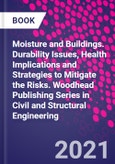Moisture and Buildings provides a critical overview of current research, knowledge and policy frameworks, and presents a comprehensive analysis of the implications of moisture and the importance of accounting for it during the design process. It responds to the urgent need for a systematic organization of the existing knowledge to identify research gaps and provide directions for future developments. The ultimate goal is to increase awareness of the multifaceted implications of hygrothermal phenomena and promote integrated design processes that lead to healthier and more durable constructions.
Please Note: This is an On Demand product, delivery may take up to 11 working days after payment has been received.








